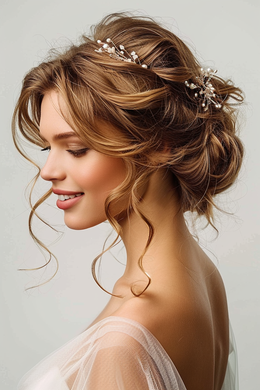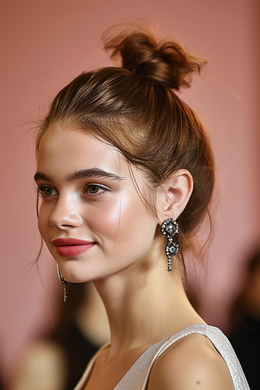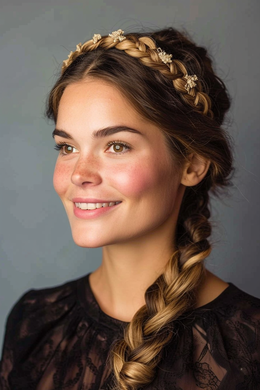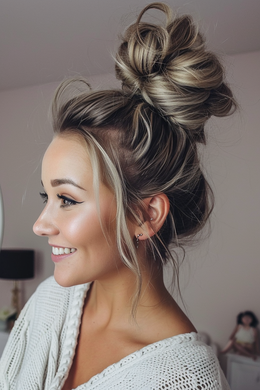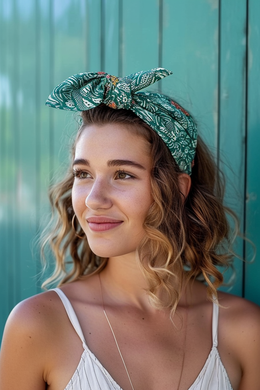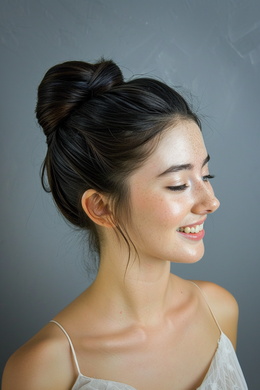Indian Hairstyles: 45+ Traditional Styles Reimagined
Dive into the elegance of Indian hairstyles, from intricate buns to flower-adorned braids. Be enchanted and inspired by the traditional craftsmanship and the vividly embellished styles.
Table of content
Indian Buns
Step into the world of Indian buns and discover one of the most traditional hairstyles that literally turns heads! In India, updos are not just a statement of good mood; they are a symbol of elegance and festivity. An Indian bun, also known as a 'Juda,' is trending and perfect for celebratory occasions. It is artfully crafted from your hair, often secured with richly decorated pins and nets. Caring for your hair is essential to ensure your bun shines and looks healthy. A small tip: use hair oil to add extra shine and keep it smooth. With a little practice and patience, you can recreate this classic look at home and feel like a goddess from the land of colors and spices.
Indian Braids
When it comes to the magic of Indian hairstyles, traditional braids are a true classic! These hair masterpieces are not only deeply rooted in Indian culture, but also make a statement of beauty and elegance worldwide. You can enhance your braid with Remy Single Drawn real hair extensions that contain no chemical additives, giving your hair a natural shine. They are also reusable for up to three years, making them a sustainable choice in your beauty routine. Whether intricately braided or styled on-trend, Indian braids are unmatched in versatility and reflect your individual style. So, take good care of your hair, so that your braid looks stunning on every occasion!
French Twists
Elegance meets tradition with the French twist – a hairstyle that showcases your hair glory to its finest. Much like the historic craftsmanship of Indian embroidery, your head transforms into a work of art. Enveloped in an aura of mystery, the French twist invites you on a journey through Indian palaces and gardens. A touch of jasmine oil or coconut makes your hair shine and prepares it perfectly for the grand entrance. Let your twist fall artistically and loosely or firm and perfectly shaped – just as the occasion demands. Meanwhile, a sturdy hairnet ensures that everything stays in place even during a wild dance. A head-turner that unfolds its splendor not only at a festival of colors under the open sky but also at formal occasions.
Flower-Adorned Braids
Imagine your hair becoming the canvas for a floral masterpiece. Flower-adorned braids are not only a stunning eye-catcher at any event, but they also pay homage to the Indian tradition where flowers hold deep symbolic meaning and are often woven into hair during weddings and festivals. To create your own flower-embellished braid, start with smooth, well-brushed hair. Braid your hair in your preferred style, whether it's a simple braid, a French braid, or even a fishtail braid, and then cleverly tuck fresh or artificial flowers into the braid. Real jasmine or roses are classics and smell heavenly, but long-lasting silk flowers can also be a magical alternative. Remember to gently set the braid with hairspray so that your artwork can withstand even the wildest dances at the festival.
Jeweled Clips
Add sparkling highlights to your hair with jeweled clips! These small accents are not only practical but also transform any hairstyle into a glamorous masterpiece. Whether you're styling a classic updo or a simple ponytail, a clip adorned with rhinestones, pearls, and intricate hand embroidery will turn heads. Originating from India, these decorative pieces offer an exquisite blend of tradition and modernity and come in a variety of designs and colors. Remember, it doesn't always have to be real gold; even gold-colored metal can appear incredibly elegant. Be sure to handle the clips carefully and protect them from water and chemicals, so you can enjoy them for a long time.
The Importance of Natural Hair Care in the Indian Beauty Ideal
In the land of spices and colors, natural hair care is an indispensable part of the beauty ideal. In India, knowledge and secrets about natural hair care methods are passed down from generation to generation. The goal: healthy, strong, and shiny hair that forms the foundation for any magnificent hairstyle. Therefore, the use of natural hair care products, free from harmful chemicals, plays an important role. From Aloe Vera to various herbs and oils, only natural ingredients are used to care for the hair and strengthen it in a traditional way.
Ritualized Hair Care Practices in the Context of Religion
Hair care in India also holds deep spiritual significance and is often associated with religious customs. While in many religions hair is seen as a symbol of strength and energy, in India hair care rituals are often performed to show respect and devotion to the gods. Gently oiling the hair can be an act of meditation and inner peace, while brushing and braiding the hair before religious ceremonies symbolizes the inner preparation for prayer.
Use of Traditional Oils and Hair Care Strategies
Traditional oils such as coconut, sesame, or amla oil are deeply rooted in Indian hair care. The warm oil massage, known as 'Champi', is more than just a treatment method; it is a cultural heritage that promotes relaxation and stimulates scalp circulation. These oils not only provide essential nutrients to the hair roots but also enhance the smoothness and shine of the hair, making them ideal for styling intricate hairstyles.
The Origin and Process of Collecting Temple Hair
The hair referred to as 'Temple Hair' originates from a unique practice of hair sacrifice, known as 'Tonsuring', which takes place in many Hindu temples. Pilgrims cut their hair as a sign of renunciation and gratitude to the deities. The collected hair is then washed, dried, and sorted by length and quality before it is processed and often used in the hair extension industry.
Temple Hair as an Ethical Dimension of the Beauty Industry
Behind every strand of temple hair lies a story of religion and tradition. The ethical dimension is significant in the beauty industry, where traceability and fair trade play a role. The profits from the sale of temple hair often flow back into the community to support social projects, which raises awareness for responsible consumption.
The Significance of Hair Donation for Indian Women and Men
In India, the offering of one's own hair to temples is deeply rooted in the culture and is viewed as an act of generosity. Women and men who donate their hair do so out of gratitude and often as a symbol of a new beginning. Such a donation is seen as a humble gesture of letting go of vanity and attachment, and therefore holds great personal and spiritual significance.
The Art of Braiding and Other Traditional Stylings
The art of hair braiding has a long tradition in India and is more than just a hairstyle; it is an expression of culture and identity. Whether simple or intricate braids like the fishtail or the crown braid, each technique carries its own story. Other traditional hairstyles, such as the Juda or the skillfully draped Sari on the hair, also demonstrate a masterful command of hair craftsmanship.
Guide to Creating Traditional Indian Hairstyles
A traditional Indian hairstyle is hard to master without practice, but with a bit of dedication, you too can create such a look. Start with healthy, well-groomed hair, section it off, and apply the right braiding technique. For a festive look, you could create a high 'Juda' or a long, sleek braid, into which you can weave fabric ornaments or flowers. A mirror and a steady hand will be your best friends on this journey.
Significance and Choice of Accessories for Indian Hairstyles
After all, no Indian hairstyle is complete without the right accessories. From sparkling hairpins to colorful flowers, the right selection can transform a hairstyle from beautiful to stunning. Choose accessories that suit the occasion and complement the colors of your clothing. Hair chains and Maang Tikka are especially popular, adorning the forehead at festive occasions, while small jasmine bouquets scent your braid at traditional events.
















































